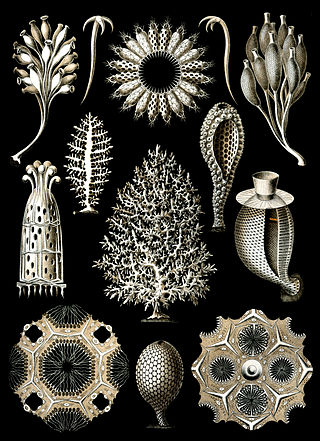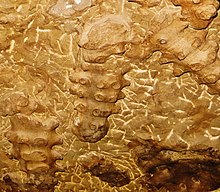
Hexactinellid sponges are sponges with a skeleton made of four- and/or six-pointed siliceous spicules, often referred to as glass sponges. They are usually classified along with other sponges in the phylum Porifera, but some researchers consider them sufficiently distinct to deserve their own phylum, Symplasma. Some experts believe glass sponges are the longest-lived animals on earth; these scientists tentatively estimate a maximum age of up to 15,000 years.

The calcareoussponges are members of the animal phylum Porifera, the cellular sponges. They are characterized by spicules made of calcium carbonate, in the form of high-magnesium calcite or aragonite. While the spicules in most species are triradiate, some species may possess two- or four-pointed spicules. Unlike other sponges, calcareans lack microscleres, tiny spicules which reinforce the flesh. In addition, their spicules develop from the outside-in, mineralizing within a hollow organic sheath.

Demosponges (Demospongiae) are the most diverse class in the phylum Porifera. They include greater than 90% of all species of sponges with nearly 8,800 species worldwide. They are sponges with a soft body that covers a hard, often massive skeleton made of calcium carbonate, either aragonite or calcite. They are predominantly leuconoid in structure. Their "skeletons" are made of spicules consisting of fibers of the protein spongin, the mineral silica, or both. Where spicules of silica are present, they have a different shape from those in the otherwise similar glass sponges. Some species, in particular from the Antarctic, obtain the silica for spicule building from the ingestion of siliceous diatoms.

Stromatoporoidea is an extinct clade of sea sponges common in the fossil record from the Middle Ordovician to the Late Devonian. They can be characterized by their densely layered calcite skeletons lacking spicules. Stromatoporoids were among the most abundant and important reef-builders of their time, living close together in flat biostromes or elevated bioherms on soft tropical carbonate platforms.

Hexasterophora are a subclass of glass sponges in the class Hexactinellida. Most living hexasterophorans can be divided into three orders: Lyssacinosida, Lychniscosida, and Sceptrulophora. Like other glass sponges, hexasterophorans have skeletons composed of overlapping six-rayed spicules. In addition, they can be characterized by the presence of hexasters, a type of microsclere with six rays unfurling into multi-branched structures.

Palaeophragmodictya is an extinct genus of sponge-grade organisms from the Ediacaran Period. Originally interpreted as a hexactinellid sponge, the organism also bears some coelomate characteristics, including bilateral symmetry.

Capsospongia, formerly known as Corralia or Corralio, is a middle Cambrian sponge genus known from 3 specimens in the Burgess shale. Its type and only species is Capsospongia undulata. It has a narrow base, and consists of bulging rings which get wider further up the sponge, resulting in a conical shape. Its open top was presumably used to expel water that had passed through the sponge cells and been filtered for nutrients.

Lyssacinosida is an order of glass sponges (Hexactinellida) belonging to the subclass Hexasterophora. These sponges can be recognized by their parenchymal spicules usually being unconnected, unlike in other sponges in the subclass where the spicules form a more or less tightly connected skeleton. Lyssacine sponges have existed since the Upper Ordovician, and three families are still alive today. The Venus' flower basket is one of the most well-known and culturally significant of the glass sponges.

Spicules are structural elements found in most sponges. The meshing of many spicules serves as the sponge's skeleton and thus it provides structural support and potentially defense against predators.
Protospongia is a genus of Porifera known from the Middle Cambrian Burgess Shale. 102 specimens of Protospongia are known from the Greater Phyllopod bed, where they comprise 0.19% of the community.
Heteractinida is an extinct grade of Paleozoic (Cambrian–Permian) sponges, sometimes used as a class or order. They are most commonly considered paraphyletic with respect to Calcarea, though some studies instead argue that they are paraphyletic relative to Hexactinellida. Heteractinids can be distinguished by their six-pronged (snowflake-shaped) spicules, whose symmetry historically suggested a relationship with the triradial calcarean sponges.

Paleontology or palaeontology is the study of prehistoric life forms on Earth through the examination of plant and animal fossils. This includes the study of body fossils, tracks (ichnites), burrows, cast-off parts, fossilised feces (coprolites), palynomorphs and chemical residues. Because humans have encountered fossils for millennia, paleontology has a long history both before and after becoming formalized as a science. This article records significant discoveries and events related to paleontology that occurred or were published in the year 2014.
Protomonaxonida is an extinct order of sea sponges. It is a paraphyletic group gathering the most ancient species from the Burgess Shale to modern sponges.

Amphidiscosida is an order of hexactinellids. The Amphidiscosida are commonly regarded as the only living sponges in the subclass Amphidiscophora.
Myrmecioptychium is an extinct lychniscosidan hexasterophoran sea sponge, which is a subgenus of Coeloptychium. Its remains have been found in Santonian-Maastrichtian-aged deposits in Broitzem, Germany and Poland. The type species, M. bodei, was named in 1912.
Sceptrulophora is an order of hexactinellid sponges. They are characterized by sceptrules, a type of microsclere with a single straight rod terminating at a bundle of spines or knobs. An anchor- or nail-shaped sceptrule is called a clavule. A fork-shaped sceptrule, ending at a few large tines, is called a scopule. A broom-shaped sceptrule, ending at many small bristles, is called a sarule.
Claviscopulia is a genus of glass sponge in the family Farreidae.
Lychniscosida is an order of sponges belonging to the class Hexactinellida and subclass Hexasterophora. They are dictyonal sponges characterized by the presence of additional struts at the nodes of the skeleton. These struts create octahedral frames, known as lychniscs ("lanterns").

Stellispongiida is an order of calcareous sponges, most or all of which are extinct. Stellispongiids are one of several unrelated sponge groups described as "inozoans", a name referring to sponges with a hypermineralized calcitic skeleton independent from their spicules. Stellispongiids have a solid skeleton encasing calcite spicules arranged in trabeculae. "Inozoans" and the similar "sphinctozoans" were historically grouped together in the polyphyletic order Pharetronida.
Labechiida is an extinct order of stromatoporoid sponges. They lived from the Early Ordovician to the Late Devonian, though a few putative fossils have been reported from younger sediments. Labechiids were the first order of stromatoporoids to appear and were probably ancestral to all other orders in the main Paleozoic radiation. They were most diverse and abundant during the Middle-Late Ordovician and the Famennian, when they were a major group of reef-building sponges. However, they were relatively uncommon through most of the Silurian and Devonian, in contrast to other stromatoporoids.











